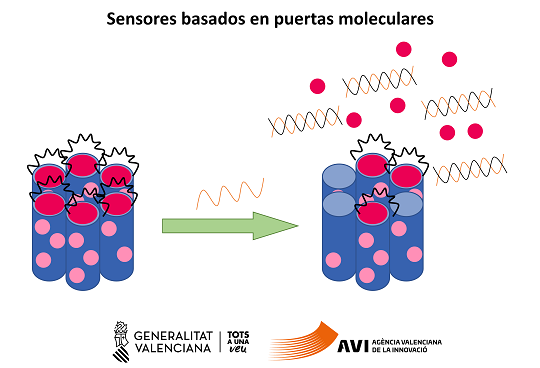
At the IDM, the NANOSENS group led by Professor Ramón Martínez Máñez uses various systems with molecular gates in different fields. In this news we will only comment on those systems that are developed in the group where the molecular gates are formed by a chain of oligonucleotides. These systems are used as detection sensors both in the agri-food field (gluten) and in the health field (infections or carcinogenic markers).
Molecular gates are supramolecular entities immobilized on a porous support whose opening mechanism depends on an external stimulus. These gates are often used to control the release of a chemical or biochemical species (cargo) that is encapsulated inside the pores of the support. Until the system is in the presence of the stimulus, the gate prevents its release. This stimulus can be of a different nature. Examples include the presence of light with a characteristic wavelength, an enzyme, or a molecule. It can also be a change in pH or temperature, or the use of ultrasound. It can be said that it is a very versatile system that can be used for multiple applications in various fields.
In relation to the detection of gluten, this system has been used as a way of keeping track of those foods intended for people with celiac disease. In this case, nanoporous anode alumina has been used as a support, in whose pores rhodamine B has been encapsulated and its release has been blocked by means of an aptamer (short simple oligonucleotide chain that selectively recognizes a protein) specific to the gliadin protein present in gluten. In the presence of the protein, the aptamer folds wrapping it, releasing rhodamine B, which is measured using a fluorimeter.
Regarding the health field, systems have been designed for the detection of mutations in gliomas, cancer markers or different pathogens. In all cases, the support and charge used were the same as in the case of gluten detection, that is, nanoporous anodic alumina and rhodamine B. What has changed in each case, depending on the biomolecule to be detected , was the molecular gate, which could be an aptamer, to detect the cancer marker, an antibody to detect the mutated enzyme, or a single chain of oligonucleotides for pathogen studies. Within the pathogens, sensors have been developed for different infections such as Candida albicans, Candida auris, Staphylococcus aureus or Pneumocystis jirovecii, obtaining very good results with shorter times than in the techniques used today. In this way, simple, fast kits have been obtained without the need for qualified personnel for the selective detection of various diseases. Some of the platforms are proprietary, such as the detection of both types of Candida.
In recent years, the IDM Scientific Innovation Unit (UCIE-IDM) financed by the Valencian Innovation Agency (AVI) has been working with a simpler detection system without the need for fluorescence equipment. It consists of the encapsulation of an enzyme inside the pores and the modulation of the access of an enzyme substrate to the inside of the pores. Only in the presence of the analyte, the door is opened and when the enzyme substrate is added, it changes color, obtaining a colorimetric sensor that indicates the presence of the analyte.









